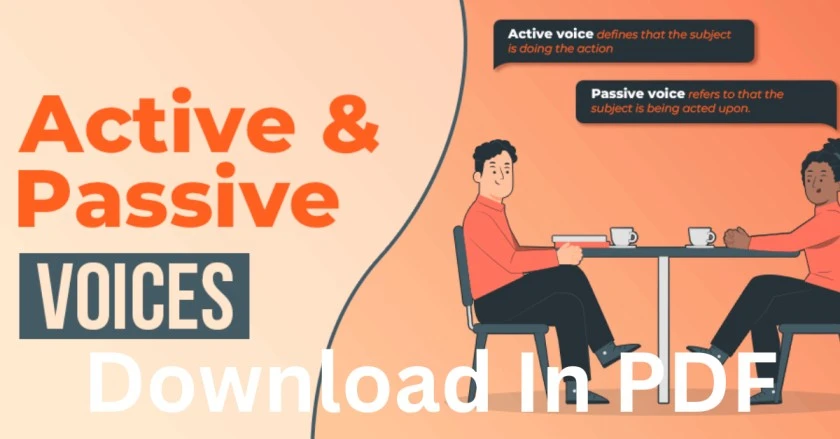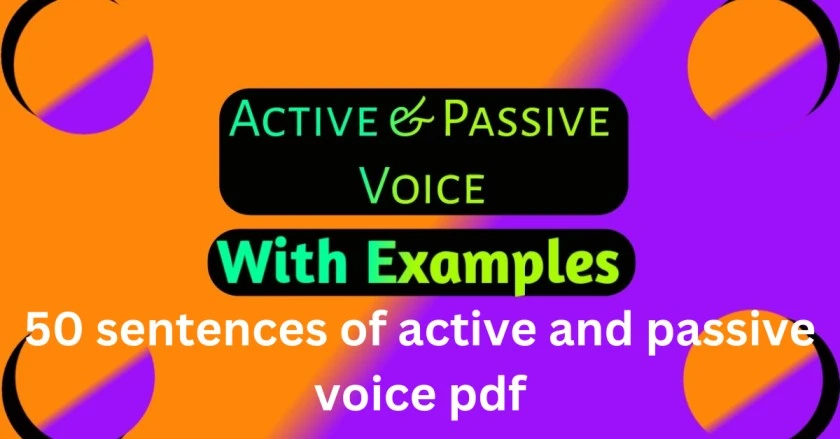Introduction
In the vast landscape of writing, understanding the nuances of active and passive voice is akin to wielding a powerful tool for effective communication. Whether you are crafting a persuasive essay, drafting a captivating story, or optimizing content for SEO, the choice between active and passive voice significantly influences how your message resonates with your audience.
Active Voice
Active voice propels sentences with a clear and direct structure, making the subject the “doer” of the action. This style enhances readability and engages the reader by providing a straightforward account of events. For instance, “The chef prepared a delicious meal,” succinctly conveys the action and the responsible party.
Examples of sentences in active voice
- The team completed the project ahead of schedule.
- The artist painted a mesmerizing landscape.
- The company achieved record-breaking sales.
Benefits of using active voice in writing
Active voice not only promotes clarity but also injects vitality into your writing. It establishes a sense of accountability, holding the subject responsible for the action, fostering a dynamic and engaging narrative.
Passive Voice
On the flip side, passive voice places the object of the action front and center, obscuring the doer. It is characterized by sentences like “The novel was written by the author,” where the emphasis is on the action rather than the person performing it. Passive voice often adds a layer of formality to writing.
Examples of sentences in passive voice
- The report was reviewed by the committee.
- The experiment was conducted by the scientist.
- The decision was made by the board.
When to use passive voice and its advantages
Passive voice is employed when the focus needs to shift from the doer to the action or when the subject’s identity is unknown or irrelevant. Its use imparts a sense of formality and objectivity, making it suitable for scientific or technical writing.
Differences Between Active and Passive Voice
Understanding the disparities between active and passive voice is crucial for effective communication. The choice between the two influences clarity, sentence structure, and the overall impact of your writing.
50 sentences of active and passive voice with answers for class

Clarity and directness
Active voice provides clear and direct communication, ensuring that the reader easily comprehends the message. In contrast, passive voice can introduce ambiguity, making it important to carefully choose when to employ it.
Subject prominence
Active voice prioritizes the subject, showcasing them as the primary agent of the action. Passive voice, however, emphasizes the action itself, relegating the subject to a secondary role.
Impact on sentence structure
The active voice typically follows a subject-verb-object structure, creating concise and impactful sentences. Passive voice, with its subject-object-verb arrangement, can result in longer and potentially more complex sentences.
Real-world application examples
To illustrate the differences, consider these real-world examples:
Active Voice
“The entrepreneur founded the company.”
Passive Voice
“The company was founded by the entrepreneur.”
Each conveys the same information but with a distinct emphasis on either the entrepreneur or the company.
When to Use Active Voice
Understanding when to deploy active voice is essential for crafting compelling narratives and maintaining reader engagement.
Writing clear instructions
Active voice is particularly effective when giving instructions. For instance, “Press the button to start the machine” is more direct and actionable than the passive alternative.
Engaging the reader
Readers connect more readily with a story or argument when the subject actively participates in the narrative.
Creating a sense of urgency
In scenarios where urgency is paramount, active voice serves to convey a swift and decisive tone. “We must address the issue immediately” resonates more urgently than its passive counterpart.
When to Use Passive Voice
While active voice is generally preferred for its clarity, there are instances where passive voice is more appropriate.
Shifting focus to the object
When the object of the action is more important than the doer, passive voice can be employed.
Emphasizing the action rather than the doer
Passive voice is useful when the emphasis is on the action itself rather than the person performing it. “The mystery was solved by the detective” highlights the resolution of the mystery.
Maintaining formality in writing
In formal writing, such as academic or technical papers, passive voice can lend an air of objectivity and impartiality. It removes the emphasis on the writer, allowing the information to take center stage.
Striking a Balance
Mastering the art of voice in writing involves knowing when to seamlessly switch between active and passive constructions.
Knowing when to switch between voices
The ability to fluidly transition between active and passive voice adds versatility to your writing. Consider the context, tone, and desired impact on the reader when making this decision.
Enhancing variety in writing
Avoiding monotony in writing is crucial for reader engagement. A judicious mix of active and passive constructions adds variety and maintains the reader’s interest.
Tailoring voice to suit the audience
Different audiences may respond differently to active and passive voice. Understanding your readership allows you to tailor your writing style to resonate with their preferences.
Common Mistakes to Avoid
Even seasoned writers can fall into pitfalls related to active and passive voice usage. Being aware of these common mistakes is the first step toward improvement.
Overusing passive voice
Overreliance on passive voice can lead to convoluted and unclear writing. Strive for balance and use passive constructions deliberately.
Neglecting the importance of subject-verb agreement
Maintaining proper subject-verb agreement is crucial, especially in active voice constructions. An oversight in agreement can compromise the clarity of your writing.
Misinterpreting tone in different contexts
Understanding the appropriate tone for different contexts is vital. Misinterpreting the formality required can result in a mismatch between your message and your audience’s expectations.
Active and Passive Voice in Different Writing Styles
The application of active and passive voice varies across different writing genres and styles.
Academic writing
In academic papers, active voice is generally preferred for its directness and clarity. However, passive voice can be employed in certain sections to maintain objectivity.
Creative writing
Creative writers often use a combination of active and passive constructions to achieve specific effects. The choice depends on the desired mood and impact on the reader.
Business and technical writing
Clarity is paramount in business and technical writing. Active voice is often favored to ensure precise communication, but passive voice can be useful in emphasizing results or actions.
Tips for Writing in Both Voices
Navigating the intricacies of active and passive voice requires a nuanced approach and attention to detail.
Understanding the context
Context is key when deciding on voice. Consider the purpose of your writing, the audience, and the overall tone you want to convey.
Balancing sentence structures
A well-balanced mix of sentence structures keeps the reader engaged. Alternate between active and passive constructions to maintain variety.
Revising and editing for clarity
Regular revisions are essential for refining your writing. Pay close attention to clarity, making sure each sentence serves its purpose and contributes to the overall coherence of the text.
Active and Passive Voice in SEO Content
In the realm of SEO, the choice between active and passive voice can impact the readability and engagement of your content.
Impact on readability and engagement
Active voice tends to be more engaging and accessible to readers, aligning with SEO best practices for creating user-friendly content.
Strategies for incorporating both voices
Strategically using both voices in SEO content can cater to a diverse audience. Combine the directness of active voice with the formality of passive voice for a well-rounded approach.
SEO best practices for content creation
Aligning your writing with SEO best practices ensures that your content reaches a wider audience. Incorporate relevant keywords naturally and prioritize user experience.
Examples from Famous Authors
Analyzing how renowned writers employ active and passive voice provides valuable insights into the art of effective communication.
How renowned writers use active and passive voice
Explore excerpts from famous works to observe how literary masters navigate between active and passive constructions to achieve specific effects.
Analyzing the effectiveness of their choices
Understanding the impact of voice choices in renowned literature allows you to draw inspiration for your own writing.
Learning from literary masters
Writers can learn from the techniques employed by celebrated authors, adapting them to their own style and voice.
Tools for Analyzing Voice in Writing
Several tools and resources are available to aid writers in analyzing their use of active and passive voice.
Online resources and software
Online platforms and software can provide valuable feedback on your writing style, highlighting instances of passive voice and suggesting improvements.
Tips for self-analysis
Developing self-awareness is crucial for refining your writing. Regularly analyze your work, seeking opportunities to enhance clarity and impact.
Improving writing skills through feedback
Constructive feedback from peers or editors can significantly contribute to your growth as a writer.
The Evolution of Voice in Modern Writing
As language trends evolve with technology, the use of active and passive voice undergoes changes.
Changes in language trends
Explore how modern communication mediums influence the way we use voice in writing.
Influences of technology on writing styles
Technology has reshaped the landscape of communication, impacting the preferences of both writers and readers.
Future predictions for active and passive voice usage
Consider the potential shifts in voice usage as language continues to adapt to new forms of expression.
Conclusion
Mastering the interplay between active and passive voice is essential for any writer seeking to communicate effectively. Both voices offer unique advantages, and understanding when and how to use them enhances the richness and clarity of your writing. As you navigate the dynamic landscape of voice choices, remember that versatility is the key to capturing the attention of diverse audiences.
FAQs
Is it always better to use active voice in writing?
While active voice is generally preferred for its clarity and directness, there are instances where passive voice is more appropriate, depending on the context and purpose of your writing.
How can I improve my awareness of active and passive voice usage in my writing?
Utilize online tools and resources that analyze your writing style, and seek feedback from peers or editors to gain insights into areas for improvement.
Are there specific situations where passive voice is recommended?
Yes, passive voice can be useful when the focus needs to shift to the action or when the subject’s identity is unknown or less important.
What impact does active and passive voice have on SEO content?
Active voice tends to be more engaging and aligns well with SEO best practices for readability. However, strategically incorporating passive voice can add variety and formality to SEO content.
How can writers strike a balance between active and passive voice?
Writers can strike a balance by understanding the context, varying sentence structures, and tailoring their voice to suit the audience and purpose of their writing.
